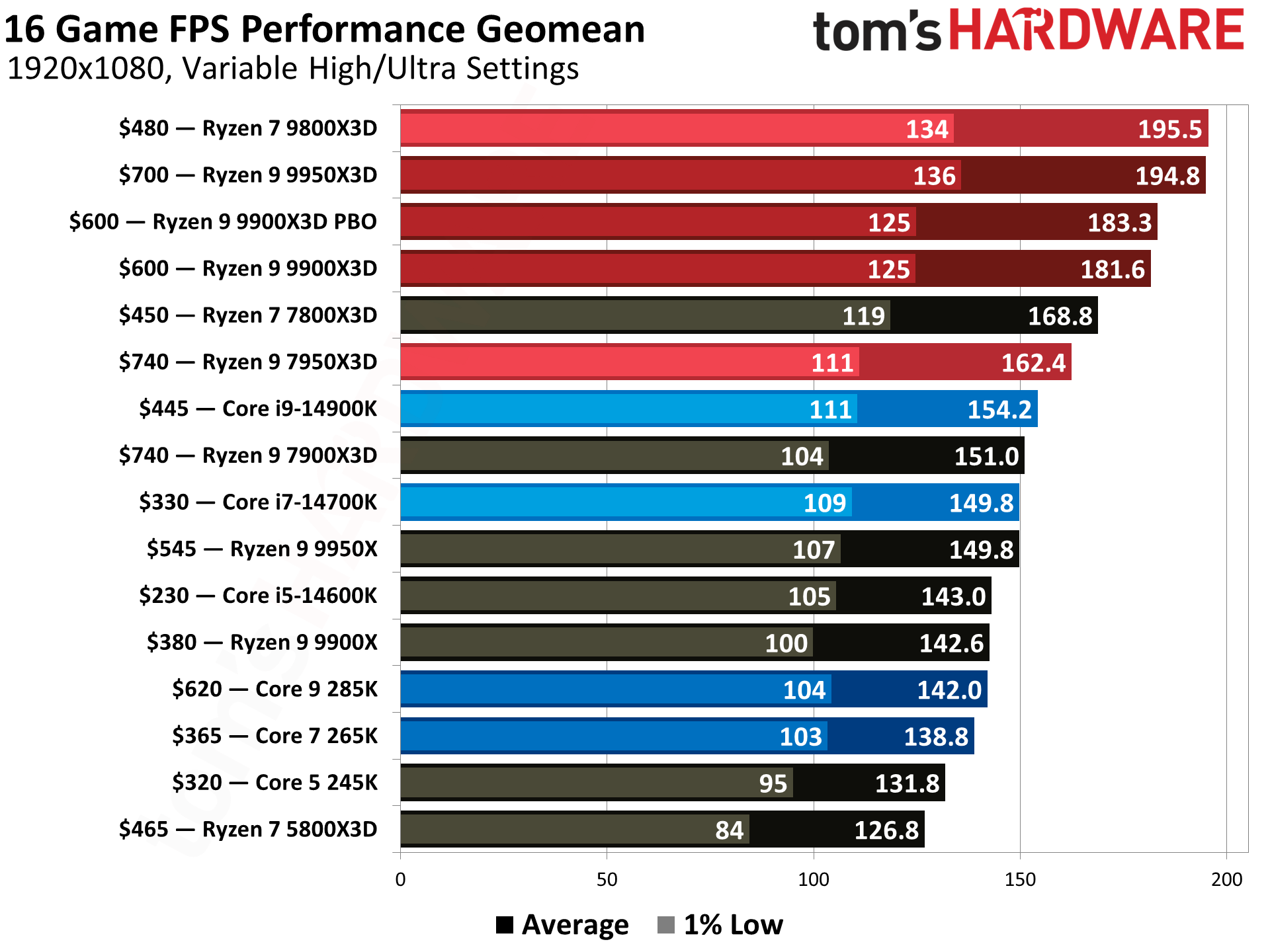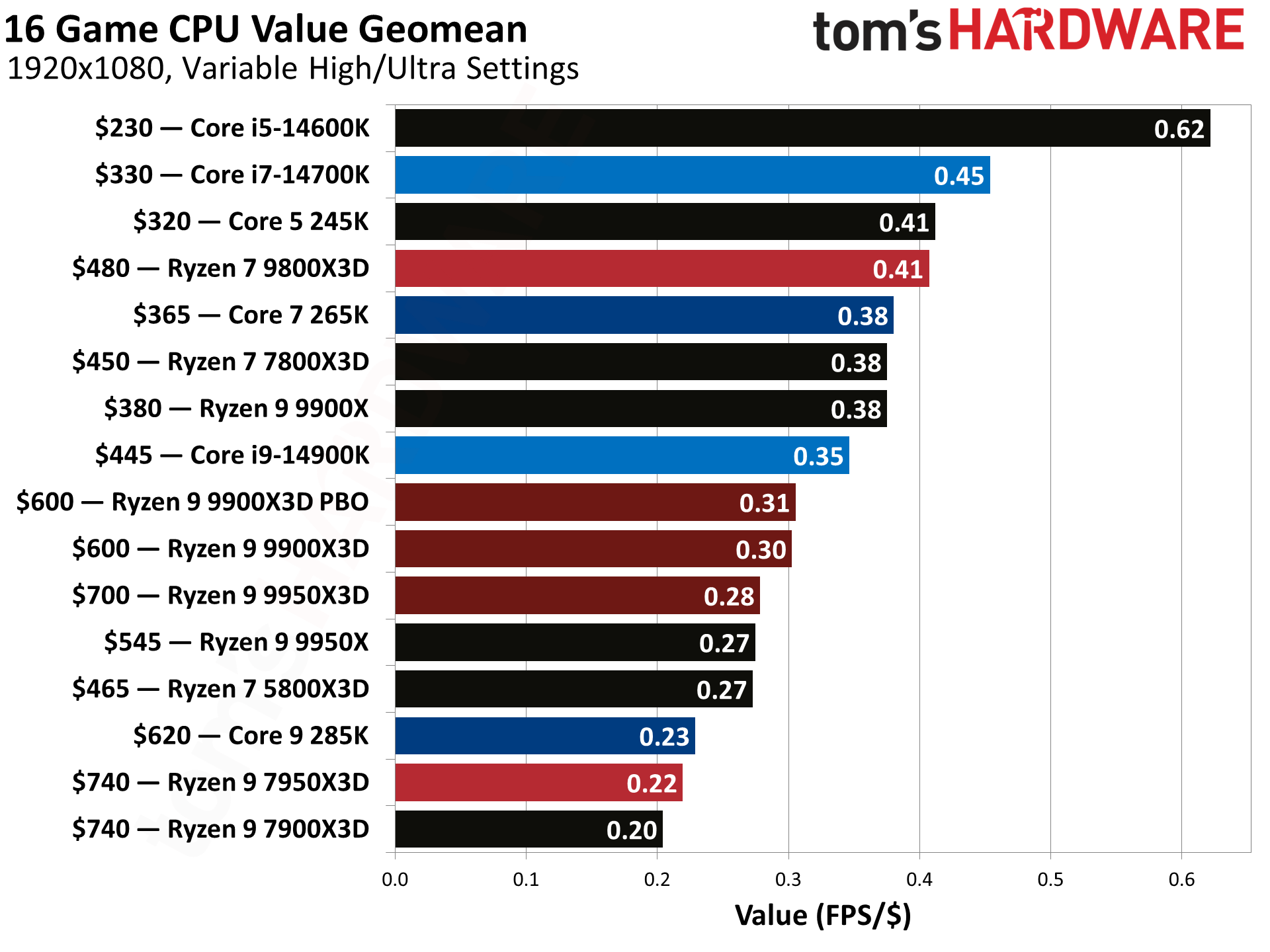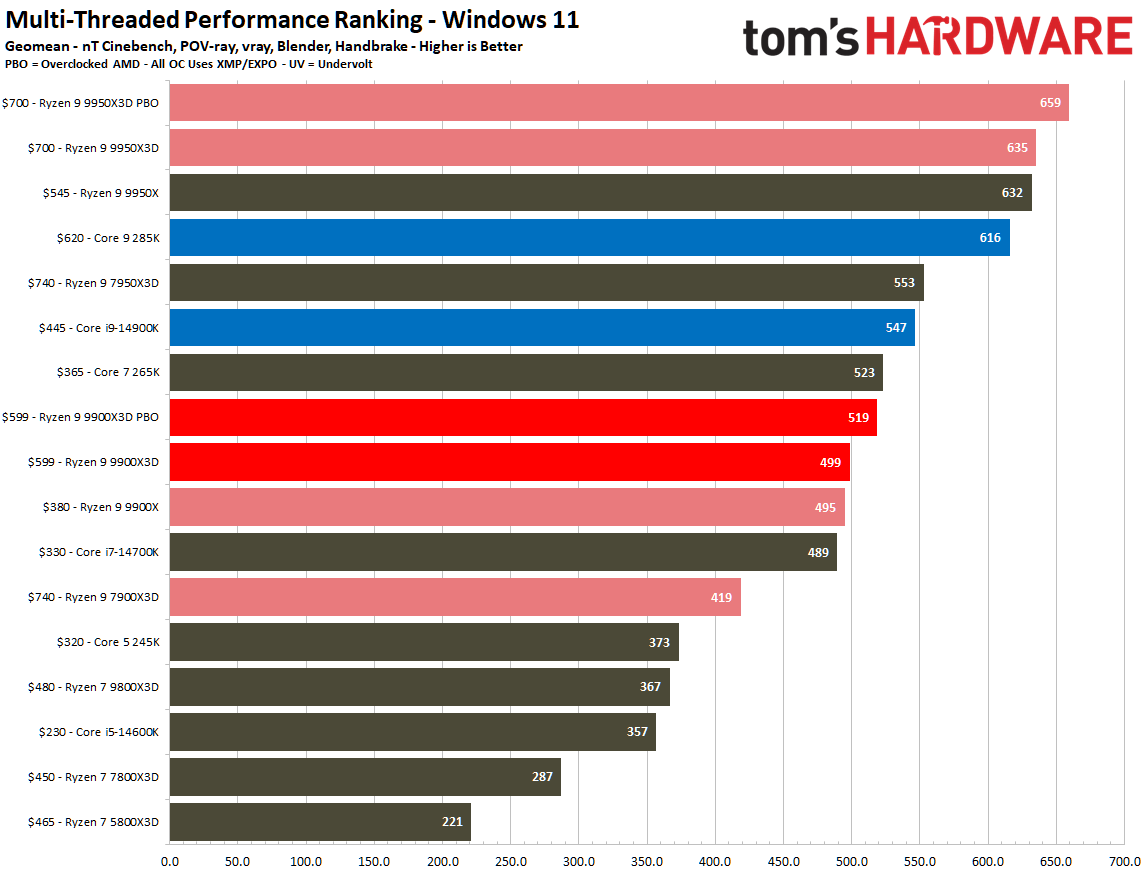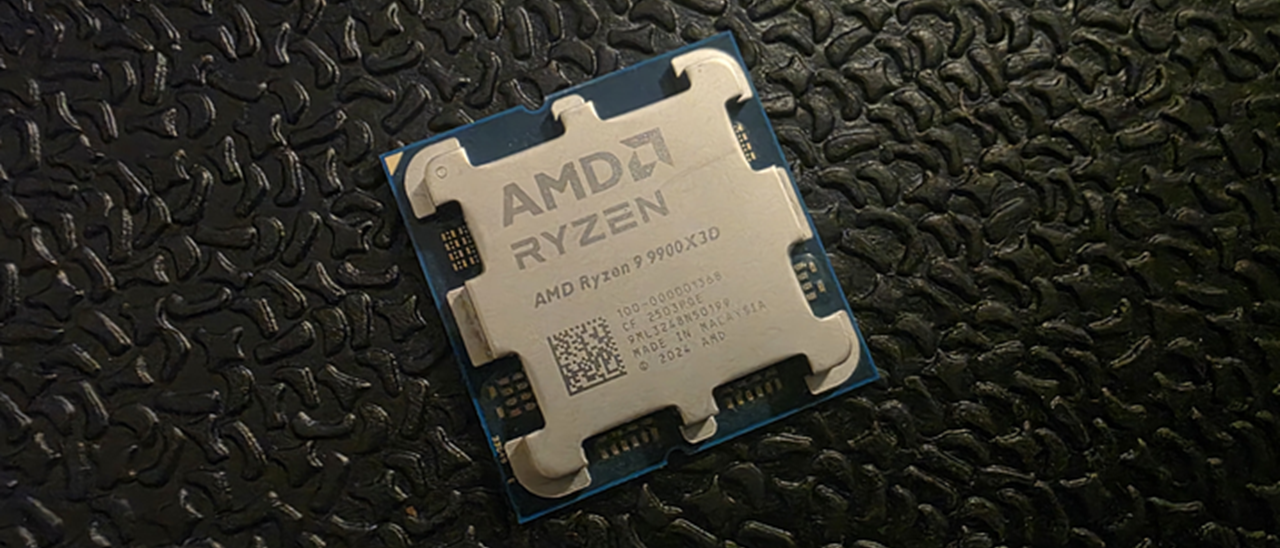Tom's Hardware Verdict
The $600 Ryzen 9 9900X3D is the fastest 12-core gaming chip on the market, but its high price point exposes it to competition from both higher- and lower-cost chips, making it hard to recommend unless it sees a significant price cut.
Pros
- +
Fastest 12-core chip in gaming
- +
Productivity performance
- +
Fully overclockable
- +
Energy efficient under load
- +
AVX-512 support
Cons
- -
Pricing makes other 3D V-Cache processors the better alternative
- -
Behaves like a 6-core X3D CPU for gaming
- -
High idle power consumption
Why you can trust Tom's Hardware
The $600 12-core Ryzen 9 9900X3D slots into AMD's 9000 X3D product stack as a midrange alternative between the current best CPU for gaming, the eight-core $480 Ryzen 7 9800X3D, and the company's flagship 16-core $700 Ryzen 9 9950X3D. The Ryzen 9 9900X3D leverages the same game-boosting 3D V-Cache technology as its X3D counterparts to deliver impressive Intel-beating gaming performance while still maintaining most of its performance potential in productivity applications, thus reducing the trade-offs of selecting one of AMD's gaming-specific processors. But not all of the news is good.
AMD has been curiously reluctant for the press to test the Ryzen 9 9900X3D — it didn't sample the chip to press, so we had to purchase it at retail. Sure, the prior-gen Ryzen 7 7900X3D wasn't received well, but AMD claimed that some of the issues with the prior-gen model have been resolved with this generation, such as reducing the performance chasm between the Ryzen 9 X3D models, and saying that the 99000X3D beats the prior-gen 16-core 32-thread flagship 7950X3D in gaming. We've put those claims to the test.
Intel isn't much of a contender, as it faces a vexing issue with its latest lineup of chips — it has no single chip that can compete with the Ryzen 9000X3D processors in both gaming and productivity work. The new Core Ultra chips aren't as fast as their prior-gen counterparts in gaming, but they serve up impressive performance in productivity applications. As a result, the $620 Intel Core Ultra 9 285K is 23% faster in multi-threaded productivity tasks than the 9900X3D, but the 9900X3D is 28% faster in gaming. Meanwhile, the prior-gen $445 Core i9-14900K shaves away some of the deficit, but the 9900X3D is still 18% faster in gaming.
CPU | Street (MSRP) | Arch | Cores / Threads (P+E) | P-Core Base / Boost Clock (GHz) | Cache (L2/L3) | TDP / PBP or MTP | Memory |
|---|---|---|---|---|---|---|---|
Ryzen 9 9950X3D | $699 | Zen 5 X3D | 16 / 32 | 4.3 / 5.7 | 144 MB (16+128) | 170W / 230W | DDR5-5600 |
$545 ($599) | Zen 5 | 16 / 32 | 4.3 / 5.7 | 80MB (16+64) | 170W / 230W | DDR5-5600 | |
Ryzen 9 9900X3D | $599 | Zen 5 X3D | 12 / 24 | 4.4 / 5.5 | 140 (12+128) | 120W /162W | DDR5-5600 |
Ryzen 7 9800X3D | $480 | Zen 5 X3D | 8 / 16 | 4.7 / 5.2 | 104MB (8+96) | 120W / 162W | DDR5-5600 |
$380 ($469) | Zen 5 | 12 / 24 | 4.4 / 5.6 | 76MB (12+64) | 120W / 162W | DDR5-5600 | |
$289 ($329) | Zen 5 | 8 / 16 | 3.8 / 5.5 | 40MB (8+32) | 65W / 88W / 105W | DDR5-5600 |
AMD's goal is to master both disciplines — gaming and productivity — with its dual-chiplet X3D processors, but that's a challenge. To build on the success of the first-gen models, the company altered its underlying 3D V-Cache design and refined its chipset drivers to deliver more accurate thread scheduling. AMD also added full overclocking support this time around, which we’ve tested, allowing you to eke out more performance in gaming and productivity work.
If you're looking for a quick take on performance, see the image album below, which breaks down performance in gaming and productivity applications. These overall measurements are backed up by our benchmarks and power testing on the following pages, so be sure to check those out. As you can see, the Ryzen 9 9900X3D is compelling, but its counterparts retain distinct advantages.




That makes the 9900X3D a better all-rounder than any competing Intel chips, but its real competition comes from within AMD's own lineup. Just as we saw with the last-gen model, the Ryzen 9 9900X3D faces a conundrum due to its price point. Let's quickly look at the 900X3D's specs, then move on to the benchmarks.
AMD Ryzen 9 9900X3D Pricing and Specifications
CPU | Street (MSRP) | Arch | Cores / Threads (P+E) | P-Core Base / Boost Clock (GHz) | E-Core Base / Boost Clock (GHz) | Cache (L2/L3) | TDP / PBP or MTP | Memory |
|---|---|---|---|---|---|---|---|---|
Ryzen 9 9950X3D | $699 | Zen 5 X3D | 16 / 32 | 4.3 / 5.7 | — | 144 MB (16+128) | 170W / 230W | DDR5-5600 |
$740 ($699) | Zen 4 X3D | 16 / 32 | 4.2 / 5.7 | — | 144MB (16+128) | 120W / 162W | DDR5-5200 | |
$545 ($599) | Zen 5 | 16 / 32 | 4.3 / 5.7 | — | 80MB (16+64) | 170W / 230W | DDR5-5600 | |
$620 ($589) | Arrow Lake | 24 / 24 (8+16) | 3.7 / 5.7 | 3.2 / 4.6 | 76MB (40+36) | 125W / 250W | CUDIMM DDR5-6400 / DDR5-5600 | |
Ryzen 9 9900X3D | $599 | Zen 5 X3D | 12 / 24 | 4.4 / 5.5 | — | 140MB (12+128) | 120W / 162W | DDR5-5600 |
$740 ($599) | Zen 4 X3D | 12 / 24 | 4.4 / 5.6 | — | 140MB (12+128) | 120W / 162W | DDR5-5200 | |
Ryzen 7 9800X3D | $480 | Zen 5 X3D | 8 / 16 | 4.7 / 5.2 | — | 104MB (8+96) | 120W / 162W | DDR5-5600 |
$450 ($449) | Zen 4 X3D | 8 / 16 | 4.2 / 5.0 | — | 104MB (8+96) | 120W / 162W | DDR5-5200 | |
$380 ($469) | Zen 5 | 12 / 24 | 4.4 / 5.6 | — | 76MB (12+64) | 120W / 162W | DDR5-5600 | |
$365 ($394) / $339 ($379) | Arrow Lake | 20 / 20 (8+12 | 3.9 / 5.5 | 3.3 / 4.6 | 66MB (36+30) | 125W / 250W | CUDIMM DDR5-6400 / DDR5-5600 | |
$289 ($329) | Zen 5 | 8 / 16 | 3.8 / 5.5 | — | 40MB (8+32) | 65W / 88W / 105W | DDR5-5600 |
As with the prior-gen Ryzen 9 7000X3D chips, the new 9900X3D uses two compute dies, with one die featuring a 3D-stacked V-Cache chiplet that increases L3 cache capacity to 128 MB. The 9900X3D's standard chiplet boosts to higher frequencies to deliver more performance in both single- and multi-threaded tasks. Overall, the Ryzen 9 9900X3D is built on the same foundation as the Ryzen 9 9900X; it just has a single L3 SRAM chiplet placed under one of the compute dies.
The Zen 5-powered Ryzen 9 9900X3D has 12 active cores and 24 threads spread evenly across the two compute chiplets (six active cores and two deactivated cores per chiplet). AMD's newly-revamped chipset drivers, which we covered in depth here, do a better job of pinning the gaming code to the single compute die with the cache.
While gaming, this technique essentially creates a six-core 12-thread processor with 3D V-Cache. Meanwhile, both the 9950X3D and 9800X3D operate as eight-core 16-thread chips while gaming, so they obviously have an inherent advantage in gaming performance, which is reflected in our benchmarks.
The 9900X3D's other cores kick in during productivity work, giving you 12 cores and 24 threads to chew through more computationally demanding work faster than you can with the eight-core 9800X3D. That said, the 9950X3D remains the king of the X3D hill for productivity work with its 16-core 32-thread design.
The 9900X3D has 140 MB of total cache and a peak boost clock rate of 5.5 GHz, a 100 MHz decline compared to the prior-gen Ryzen 9 7900X3D. Both chips have the same 5.5 GHz base clock. Like its predecessor, the 9900X3D has a 120W TDP and a 162W PPT (maximum power draw). We have extensive power testing on the following pages as well.
Let's move on to the gaming, productivity, and workstation benchmarks on the following pages.
- MORE: Best CPU for gaming
- MORE: CPU Benchmark Hierarchy
- MORE: Intel vs AMD
- MORE: How to Overclock a CPU
Get Tom's Hardware's best news and in-depth reviews, straight to your inbox.

Paul Alcorn is the Editor-in-Chief for Tom's Hardware US. He also writes news and reviews on CPUs, storage, and enterprise hardware.
-
m3city High power usage in iddle, really? One could draw some conclusions based on graphs provided, but definitely not that.Reply -
Neilbob Really not sure why AMD are bothering with the #900 X3D variants. Neither the price or the performance fit, in either direction. Those 6 core chips with the extra cache would be far better diverted to a cheaper #600 X3D if there are enough defective dies to bother, that is.Reply
If it was another 50-75 of your chosen currency cheaper, then it might be more interesting. -
logainofhades I agree that they should just sell these dies as a 9600x3d, and skip the 9900x3d altogether.Reply -
Heat_Fan89 From reading and hearing several reviews (Gamers Nexus), i'm surprised that the 9950X3D and 9900X3D did not demolish the lesser and older 9800X3D. In fact Steve Burke from GN, said the 9950X3D was on par with the 9900X3D and 9800X3D. I decided for my gaming build to go with the 9800X3D, not because of price but the 9800 was the choice for a gaming rig. I recently snagged a new 9800X3D on sale from Amazon for $443.Reply -
JarredWaltonGPU Reply
Why not? Are you missing these charts?m3city said:High power usage in idle, really? One could draw some conclusions based on graphs provided, but definitely not that.
https://cdn.mos.cms.futurecdn.net/Wpec6VRKFNm8Yz2XX46WN3.pnghttps://cdn.mos.cms.futurecdn.net/MZ7DJqYn2gNn4vTHK9aWJ3.png
In idle and light workloads, AMD's CPUs are sitting about 14~17 watts higher than the Core Ultra 9 285K. Is that a terrible thing that should prevent people from buying it? No, but it is a weakness of AMD's design right now. It's something AMD should look into addressing with future designs. Because even though it's only 15W or so (that's two 60W LED bulb equivalents), it should be possible to get that power use down.
Imagine a phone or mobile device that used almost 3X more power at idle than the competition. That would be a major concern. And in light workloads like YouTube, if it had to use twice as much power, that would also be bad.
Some people seem to think the pros and cons are us screaming "THESE ARE AMAZING ASPECTS" and "THESE ARE TEH WORST ASPECTS" but they're really just a high-level summary of some key points — things that are going well, things that could be improved (without the shouting).
I'm not sure why anyone would be surprised that, in gaming, the 8-core X3D and the 8-core X3D plus 8-core standard CCDs perform better in games than a 6-core X3D plus 6-core standard configuration. The whole point of the X3D is to shift cache-sensitive workloads to that CCD, away from the other CCD that lacks the extra cache.Heat_Fan89 said:From reading and hearing several reviews (Gamers Nexus), i'm surprised that the 9950X3D and 9900X3D did not demolish the lesser and older 9800X3D. In fact Steve Burke from GN, said the 9950X3D was on par with the 9900X3D and 9800X3D. I decided for my gaming build to go with the 9800X3D, not because of price but the 9800 was the choice for a gaming rig. I recently snagged a new 9800X3D on sale from Amazon for $443.
It's a whitelist software solution (meaning, AMD explicitly lists which games should effectively disable the non-X3D CCD), and not everything benefits. But as we've seen plenty of times in the past, the dual-CCD (and quad-/hex-/octal-CCD Threadripper) solutions add latency to memory and cache transactions and that reduces gaming performance.
In fact, that's precisely the problem Intel has with Arrow Lake: higher memory latency means lower gaming performance. -
usertests Reply
Higher margin on the chip, perhaps? Although the street price is already below MSRP.Neilbob said:Really not sure why AMD are bothering with the #900 X3D variants. Neither the price or the performance fit, in either direction. Those 6 core chips with the extra cache would be far better diverted to a cheaper #600 X3D if there are enough defective dies to bother, that is.
This should be the last hurrah for the awkward AMD 12-cores. Zen 6 will move to 12-core chiplets. The equivalent chip in that lineup might have 16, 18, or 20 cores, a minimum of 8 cores in each CCX. The 3D cache whitelisting problem could persist, but the single-CCD 9800X3D successor will have 12 cores and walk all over the 9900X3D in every scenario. -
Neilbob Reply
Oh, I definitely understand the reason for it, but I like to delude myself in to thinking that AMD would do something 'nice' for us dinky liddle consumers. I know; I may as well wish for world peace, with a mysterious multi-million inheritance thrown in.usertests said:Higher margin on the chip, perhaps? Although the street price is already below MSRP.
Then again, I can't see how a 9600X3D wouldn't sell like hot cakes at 300, or even a bit more. -
usertests Reply
The other reason they are wary of doing a wide, early release of 6-core X3D is because it clearly undercuts the 8-core X3D for the many games that are fine running on 6 fast cores.Neilbob said:Oh, I definitely understand the reason for it, but I like to delude myself in to thinking that AMD would do something 'nice' for us dinky liddle consumers. I know; I may as well wish for world peace, with a mysterious multi-million inheritance thrown in.
Then again, I can't see how a 9600X3D wouldn't sell like hot cakes at 300, or even a bit more.
They could probably get away with charging $350 for a 9600X3D, but if it costs about the same to make as $480+ 9800X3D due to high yields, a chunk of money is left on the table. So it will probably get introduced much later in this generation when enough defective chips are accumulated, following the pattern. -
Albert.Thomas "We measured the Core Ultra 9 285K at 20W under these conditions, but the Ryzen 9 9900X3D consumed 37W. While we can see that the 9900X3D has improved compared to the previous-gen Ryzen 7000X3D models, this is still a significantly higher amount of active idle power draw than the Intel chips."Reply
What about medium-light conditions Paul?
I've been able to pull a (relatively) insane amount of power with the 9950X3D just by spinning my mouse around really quickly.
With the disclaimer that I haven't tested this in detail, it appears that AMD's flagship X3D CPU is much less efficient below 100W, but is more efficient above 100W. -
Notton What AMD really needs is an 8+4, not a 6+6Reply
Although, judging by the amount of binned 4-cores they sell, it seems the yields are so good they have almost none.
